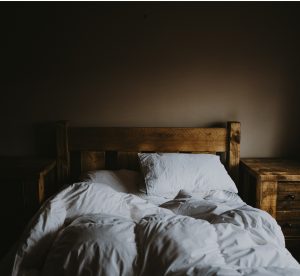Sleep is a vital to our ability to function – and not because it’s a chance for your mind and body to recharge so you’re refreshed and ready for the day ahead – it plays an essential role in literally every part of our lives. Sleep helps to keep us fit and healthy by bolstering our immune system, it can improve our problem-solving skills, help us to retain knowledge, has an impact on our cognitive development, and is crucial to keeping ourselves and others safe.[1]
So with the average adult needing around 7 hours sleep a night, what do you do if you’re not getting a good night’s sleep? Here are my top 7 tips I’ve suggested to client’s who’ve come to my treatment room in Bury St Edmunds over the years.
How to Get a Good Night’s Sleep
- Develop a good routine where you get ready for bed at the same time and aim to wake up at the same time.
- Avoid caffeinated, sugary drinks and alcohol instead try herbal tea or milky drinks, and stick to snacks like nuts, berries – and kiwi’s!
- Keep your bedroom dark and cool – and for sleeping and lovin’ only!
- Dim the light on the screens of your phones and other electronic devices, and try to avoid answering messages and scrolling before bedtime
- If you’re struggling to fall asleep after 25 minutes then get up, leave the bedroom and reset with a drink, perhaps read a book, do a jigsaw, only returning back to bed when you’re tired.
- Try a distraction technique like writing or listening to a podcast / guided mediation.
- Get some health and wellbeing support from a professional.
1. Develop a good routine where you go to bed at the same time and wake up at the same time
Your body loves routine, especially when it comes to sleep, and this includes going to bed at the same time and waking up at the same time.
A bedtime routine could also include a little bit of self-care, for example practicing some mindfulness or meditation, or even incorporating some hand reflexology. Head on over to my YouTube channel for a video on a hand reflexology routine for sleep, and to SoundCloud for some guided meditations suitable for you and your children.
2. Avoid caffeinated, sugary drinks and alcohol instead try herbal tea or milky drinks, and stick to late snacks like nuts, berries – and kiwi’s!
It’s universally agreed you should avoid caffeinated and sugary drinks in the afternoon, so you might want to consider changing over to herbal teas like ginger or chamomile, or to naturally caffeine free drinks like Rooibos (also called Red Bush) which can be drunk black or with milk. And although alcohol can make you feel sleepy the side effects of dehydration the need to urinate more frequently and night sweats can ultimately disrupt your sleep so avoid it if you can.
The food you eat may also help, and those in the know suggest nuts, cherries, bananas, oranges, berries, prunes, raisins and plums as great evening snacks. There’s also been a tiny study conducted in Taiwan with 20 women and 2 men, all of whom had a self-diagnosed sleep disturbance, who were asked to eat 2 kiwis each, one hour before bedtime, each night for 4 weeks [2]. Those taking part reported falling asleep quicker, for longer, and sleeping more soundly, so who knows? Maybe kiwi’s hold the answer!

3. Keep your bedroom dark and cool – and for sleeping and lovin’ only!
Keep your bedroom as your bedroom! Keep the TV out and only use it for sleeping and lovin’! It should also be cool and dark, and somewhere you want to be, so remove anything you don’t want in there.
When it gets dark our body releases a hormone called Melatonin which signals to the body it’s time to sleep, as a result we become more tired. A reduction in temperature is another sign it’s time to sleep, so consider diming lights and reducing the temperature in your bedroom to around 18ºC [3].
4. Dim the light on the screens of your phones and other electronic devices, and try to avoid answering messages and scrolling before bedtime
The research conducted into blue light ISN’T as conclusive as it’s often portrayed [4], with some studies suggesting those who have their devices on before bedtime only take 10 minutes longer to fall asleep than those who have them switched off. What is more likely to be disrupting sleep is the constant checking of emails and messages, and aimless scrolling through social media or the internet, leaving your minds awake and buzzing with information.
So, if you can’t live without your device an hour before bedtime keep them on but apply a blue light filter, dim the brightness of your screen, AND try to set a time that you will stop looking at it!
5. If you’re still struggling to sleep after 25 minutes then get up and out of bed and re-start your bedtime routine
If you’re struggling to sleep or you wake in the night and can’t get back to sleep, experts suggest you should get up and out of bed and go to a different room after 25 minutes [5]. This makes sure you don’t start associating your bedroom with not being able to sleep, it removes anxiety by taking yourself away from the situation, and restarting your bedtime routine, perhaps by having a warm drink or reading a book, helps you reinforce it – only returning to bed once you’re feeling sleepy.

6. Try a distraction technique like writing or listening to a podcast / guided mediation
Sometimes a distraction is all you need to get yourself on track for sleep. You could try listening to an audiobook, a guided meditation or even a podcast.
7. Get some health and wellbeing support from a professional
We all experience disturbances in our sleep from time to time and generally ‘time’ will sort it out. But if your sleep disturbances continue and are having a detrimental impact on your health and wellbeing it’s important you to speak to your GP to determine if you a sleep disorder that requires additional specialist support.
Complementary and holistic therapists may be able to help to mitigate some of the causes of sleep disturbances, for example helping to reduce the impact of stress and anxiety and may be able to offer additional support alongside your GP’s advice for diagnosed sleep disorders like Insomnia and Restless Leg Syndrome.
The key thing with sleep disturbances is not to get too anxious about them. Take a step back if you can and work on establishing a positive sleep routine using the tips above, seeking additional support, advice and guidance if you need to.
Contact me for more information if you’re interested in finding out how Reflexology, Bowen Therapy or Reiki may help with your sleep.
sarah@sarahwoodhousetherapy.co.uk | 07715213392 | follow me on Instagram and Facebook @sarahwoodhousetherapy
References
[1] For example, “drowsy driving kills or seriously injures twice as many people each year on Britain’s roads as drug use, and about one-third of the. Number of people killed by drunk-driving.” Lockley and Foster, 2012: SLEEP: A Very Short Introduction, Oxford University Press p103
[2] https://www.ncbi.nlm.nih.gov/pubmed/21669584
[3] https://www.ted.com/talks/matt_walker_6_tips_for_better_sleep?referrer=playlist-sleeping_with_science
[4] https://www.sciencedaily.com/releases/2019/12/191216173654.htm
[5] https://www.ted.com/talks/matt_walker_6_tips_for_better_sleep?referrer=playlist-sleeping_with_science






